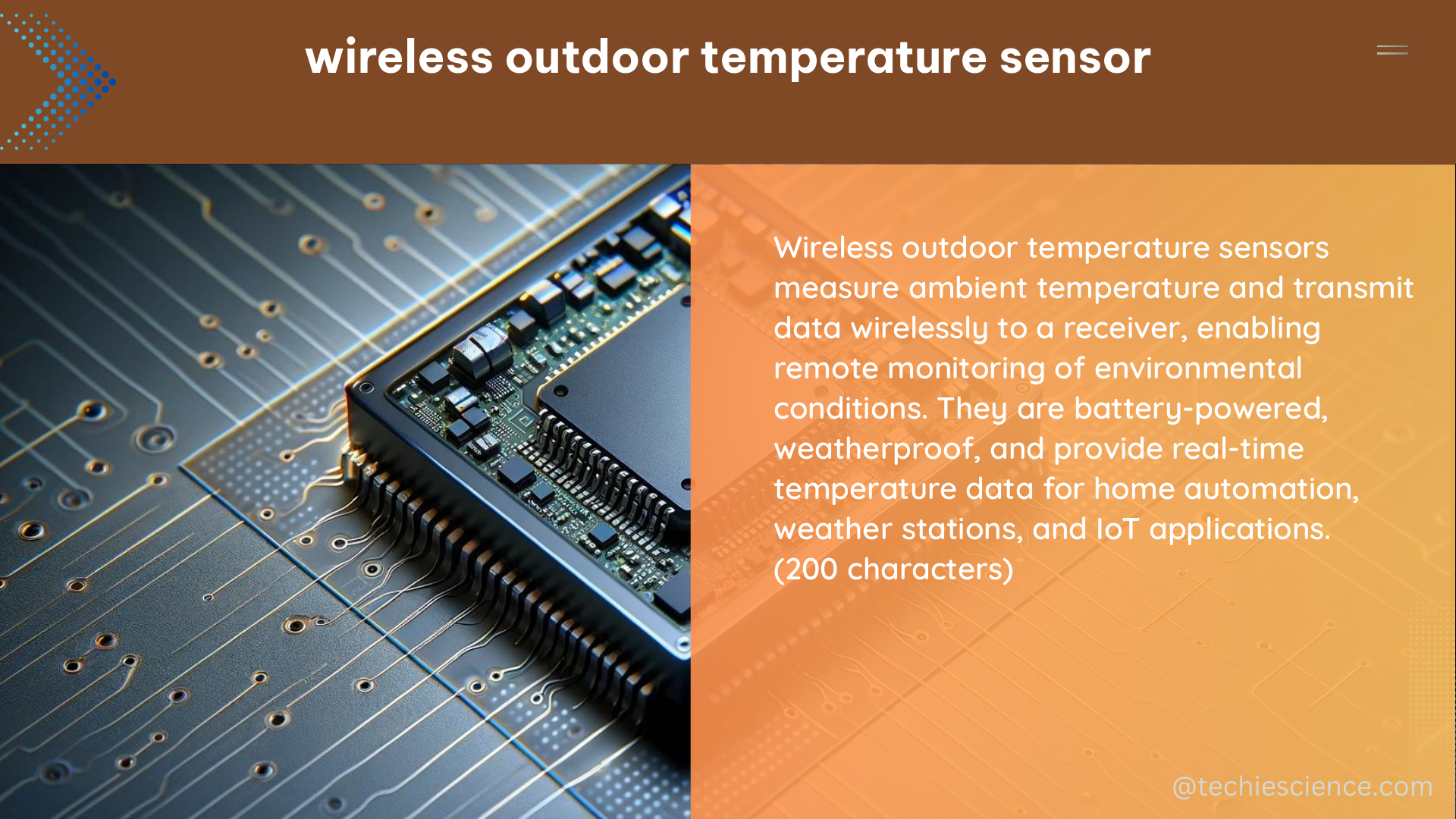Wireless outdoor temperature sensors are versatile devices that measure the temperature in an outdoor environment and transmit the data wirelessly to a receiver or a central system. These sensors are widely used in weather monitoring, HVAC systems, agricultural applications, and other scenarios where temperature data needs to be collected from an outdoor location.
Key Factors to Consider When Selecting a Wireless Outdoor Temperature Sensor
When choosing a wireless outdoor temperature sensor, there are several crucial factors to consider:
Measurement Range
The measurement range refers to the temperature range that the sensor can measure, typically specified in degrees Celsius or Fahrenheit. Common measurement ranges for wireless outdoor temperature sensors include:
– -40°C to +125°C (-40°F to +257°F)
– -20°C to +50°C (-4°F to +122°F)
– -10°C to +50°C (+14°F to +122°F)
The choice of measurement range depends on the specific application and the expected temperature conditions in the outdoor environment.
Accuracy
Accuracy is the degree to which the sensor’s measurements correspond to the actual temperature. It is usually expressed as a tolerance in degrees, such as ±0.5°C or ±1°F. High-precision sensors can achieve an accuracy of ±0.1°C or better, while more affordable sensors may have an accuracy of ±1°C or ±2°F.
Wireless Range
Wireless range is the distance over which the sensor can transmit data to the receiver. This is typically specified in feet or meters and can vary widely depending on the wireless technology used, the antenna design, and the presence of obstacles between the sensor and the receiver. Common wireless ranges for outdoor temperature sensors include:
– 100 feet (30 meters)
– 300 feet (90 meters)
– 1000 feet (300 meters)
– 2500 feet (760 meters)
Power Source
Wireless outdoor temperature sensors can be powered in various ways, including:
– Battery-powered (e.g., CR2032, AA, or AAA batteries)
– Solar-powered with a backup battery
– Wired power supply (e.g., 5V or 12V DC)
The choice of power source depends on the sensor’s power consumption, the expected battery life, and the availability of a power source in the outdoor location.
Durability
Durability is a crucial factor for outdoor sensors, as they must be able to withstand exposure to the elements, including rain, snow, and extreme temperatures. Wireless outdoor temperature sensors are typically designed with weatherproof or water-resistant enclosures and may have features like UV-resistant housing, corrosion-resistant materials, and impact-resistant construction.
Examples of Wireless Outdoor Temperature Sensors

ThermoPro TP260B Indoor Outdoor Thermometer Wireless 1000ft
The ThermoPro TP260B is a wireless outdoor temperature sensor that features an advanced Swiss-made Sensirion sensor. It measures temperature precisely within ±0.5°F and has a wireless range of up to 1000 feet. The sensor is powered by a CR2430 battery and is designed for both indoor and outdoor use, with a temperature range of -4°F to 158°F (-20°C to +70°C).
DS18B20 Temperature Sensor Data Over Wireless
The DS18B20 Temperature Sensor Data Over Wireless project uses a DS18B20 temperature sensor and 315/433 MHz RF modules to transmit temperature data wirelessly. This Arduino-based project has a temperature measurement range of -55°C to +125°C and an accuracy of ±0.5°C over the range of -10°C to +85°C. The RF modules have a wireless range of up to 25 feet line of sight with a 12 cm antenna on the receiver and a 95 cm antenna on the transmitter.
Reverse Engineering Wireless Temperature Sensors
Another approach to creating a custom wireless outdoor temperature sensor is to reverse engineer off-the-shelf sensors. In a blog post, the author describes how he reverse engineered a few wireless temperature sensors and used an Arduino to listen to and decode the sensor data. This approach requires a good understanding of electronics and programming, but can result in a highly customized solution that meets specific requirements.
Conclusion
Wireless outdoor temperature sensors are versatile and useful devices that can be used in a variety of applications. When selecting a sensor, it is important to consider measurement range, accuracy, wireless range, power source, and durability. Examples of wireless outdoor temperature sensors include the ThermoPro TP260B Indoor Outdoor Thermometer Wireless 1000ft and the DS18B20 Temperature Sensor Data Over Wireless project. Reverse engineering off-the-shelf sensors is another approach to creating a custom solution.
Reference:
– ThermoPro TP260B Indoor Outdoor Thermometer Wireless 1000ft
– Arduino DS18B20 Temperature Sensor Data Over Wireless
– Reverse Engineer Wireless Temperature, Humidity, and Rain Sensors

The lambdageeks.com Core SME Team is a group of experienced subject matter experts from diverse scientific and technical fields including Physics, Chemistry, Technology,Electronics & Electrical Engineering, Automotive, Mechanical Engineering. Our team collaborates to create high-quality, well-researched articles on a wide range of science and technology topics for the lambdageeks.com website.
All Our Senior SME are having more than 7 Years of experience in the respective fields . They are either Working Industry Professionals or assocaited With different Universities. Refer Our Authors Page to get to know About our Core SMEs.